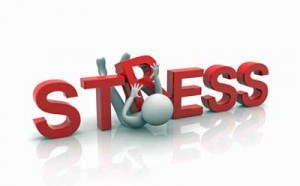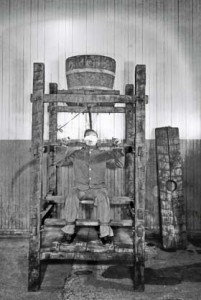



“An intriguing and clinically relevant question is whether training individuals to alter their cognitive and affective response to nociceptive input might mitigate or reverse central sensitization.”
For good reasons ‘catastrophizing’ is something of a dirty word in the ME/CFS community.

Catastrophizing involves focusing on the worst that can happen, ruminating about a stress situation, feeling overwhelmed, etc.
Some people with Chronic Fatigue Syndrome and Fibromyalgia have been told their disorder may be associated with or even caused by ‘catastrophizing’ – a mindset that involves seeing the worst in one’s future.
Studies have shown, though, that only a subset of people with ME/CFS catastrophize and that it is present in many (probably all) disorders. In fact a recent blog revealed that you don’t need to be ill to catastrophize or experience pain sensitization, you simply need to be human.
In fact, it showed that even pain researchers with an intimate knowledge of pain sensitization and catastrophizing can get hit by it.
Pain Researcher Falls Prey to Catastrophizing
Step One – Pain Sensitization
The story went like this. Carl Lyon Baeyer purchases a $1200 walking treadmill to enable him to exercise and work in his office at the same time. He quickly learns to walk, think, and dictate text with little (as he puts it) ‘cross-task interference’. He’s happy for about six weeks, but then begins to notice a ‘powerful aversive’ sensation as he walks. He feels like he has little pieces of gravel in his shoes, and repeatedly examines them but finds nothing. Clearly the brain is very capable of misinterpreting signals from the body, even in healthy people.
He rated the pain level at about a three but the unpleasantness factor at about an eight (!); it was a very unpleasant sensation. It never happened unless he was on the treadmill.
Step II: Catastrophizing
It didn’t take long for the catastrophizing to set in. Catastrophizing essentially refers to thought patterns which consistently interpret a situation in negative ways. (Note that catastrophizing is a human condition that can probably be instilled in most of us if we’re confronted by enough negative situations.)
For instance, after 10 years or so of fruitlessly trying treatments, a little voice in my head stating “You’ll never get better” grew louder and louder. You could call that little voice the ‘voice of experience’. It was a more or less logical interpretation of my situation that was based on experience.
It’s also true that the future of giving in to the statement “I’ll never get better” is not a pleasant one, and given that I know of people who have gotten better, perhaps not a particularly accurate one. (It’s only me who the little voice said couldn’t get better :)).
Other catastrophizing thoughts include statements like “I can’t handle this”, being focused (obsessed?) on how much pain or how exhausted I am, thinking the worst ( “I’m just going to get worse”) and feeling emotionally and mentally overwhelmed by it all.
The pain researchers’ catastrophizing thoughts included
- “I wasted $1200!”
- “I will never be able to use this treadmill!”
- “My fitness plan is ruined!”
- “I will have to go back to sitting at a desk!”
The thoughts eventually came so fast and heavy that he found he was unable to concentrate on his work when he was on the treadmill, which, of course, defeated the purpose of the treadmill and led to more catastrophizing thoughts such as “what an idiot I am – I can’t even focus on m work any more.”
After weeks of this the light bulb finally went on; he was suffering from something that, as a sensory researcher, he saw in his lab daily. “I was experiencing neural sensitization to the prolonged and regular repetition of identical physical stimuli produced by walking on the treadmill,” or something akin to “Chinese Water Torture”.
Chinese Water Torture
Chinese Water Torture (which as it turns out originated in Europe) involves letting water drops fall on the same spot on someone’s forehead over a long period of time. The repetitive nature of the drops causes ‘windup’ or pain sensitization.
For whatever reason putting his feet in those shoes on that treadmill had the same effect. As his brain had become sensitized to those sensations it had produced allodynia (interpreting a normal touch as painful) and what’s called ‘windup’. Instead of turning off its attention to an innocuous sensation, the brain continually upped its attention to that sensation.
He called the experience ‘dramatically distressful and disabling’.
Note that all this was in a healthy pain researcher.
The ‘Cure’
Baeyer never got rid of the feeling of small, sharp gravelly stones in his shoes when walking on the treadmill (pain intensity three) but he was able to reduce the unpleasantness factor substantially (from an ‘8’ to a ‘3’).
Baeyer partially resolved his sensitization problem and his catastrophizing problem by ‘varying the stimulus’ so that his brain couldn’t latch onto it so readily and then go into its ‘windup’ phase where it ramps up his pain levels.
He did this by changing how he walked on the treadmill. When the gravel sensation starts he kicks off his shoes and walks barefoot. Then he varies the speed on the treadmill so that his feet strike it at different angles. He walks on different parts of his feet. Sometimes he just stands. Essentially he’s varying the stimuli sent to the brain so as to reduce its sensitization.
That in turn reduces his catastrophizing thoughts; i.e., he doesn’t feel helpless anymore. The treadmill is no longer a junker, and he’s no longer kicking himself for having bought it. He’s no longer feeling inadequate about dealing with this situation and he’s able to concentrate on his work again. He’s found a way to bypass a neurological problem he developed.
Catastrophizing, Fatigue and Pain
A study examining the effects of catastrophizing on fatigue across several conditions highlighted how loosely defined a concept catastrophizing is. Studies even within the same condition measure catastrophizing in such different ways that it’s hard to relate one study to another.

Study results across a variety of disorders suggest high ‘catastrophizers’ experience more fatigue and pain.
One study, which measured the degree of catastrophizing present in ME/CFS by the answer to this question: “What would be the consequences of pushing yourself beyond your present physical state”, ignored the huge range of severity present in this disorder. Not surprisingly, people who expected greater consequences were more fatigued and were portrayed as ‘catastrophizers’.
However, the study results are pretty consistent across a range of disorders including cancer, multiple sclerosis, ME/CFS, and FM. They suggest that if you’re doing low to moderate levels of catastrophizing, it’s probably not affecting you much. But if you’re catastrophizing a lot, it could be exacerbating your pain and fatigue significantly.
If any disorders are set up for catastrophizing, ME/CFS and FM with their variable presentations (not knowing when you’re going to feel worse, or what causes it), the lack of treatments (‘It’s never going to get better’), and the activity restrictions (leaving plenty of time for ruminating :)) would seem to be the ones.
Personal Interlude
I recently went through a recent sensitization/catastrophizing period. After my truck was totaled in an accident I replaced it with a Toyota 4Runner. By the time I got the 4Runner home from the car dealer my back was hurting and, seemingly out of nowhere, my plantar fasciitis had flared up. I hadn’t had plantar fasciitis pain for almost twenty years, but it took it no more than 30 minutes for my heels to be throbbing with pain. For some reason the way they sat on the car floor immediately inflamed them.
Over the next month the pain waxed and waned and then got worse. Not only did my heels hurt in the car but also they hurt outside of the car. They hurt when I was walking. They hurt when I was sitting. I changed my shoes. That helped for a couple of days and then the pain was up again.
Of course, I was ruminating like crazy. It was such a bizarre situation. I had thoughts such as, “This is unbelievable! Who would buy a car and then have heel problems? Would this happen to anybody else but me? No!” I wondered if I would have to trade the truck in at some point, and thought, “That would just take the cake; how weird that would look! There goes ‘weird Cort’ again.” It would be embarrassing as all heck.
It’s not like nothing real was happening. Reviewers have taken the Toyota 4Runner to task for its weird seating position and it did immediately inflame my heels, but being engulfed emotionally in the situation did not help.
I did what Baeyer did. I varied my foot position. I changed how the seat was positioned. I took off my shoes when driving and I knocked off the negative thoughts and, at least for now, it’s much better. I learned once again that when you direct your mind to pain, you almost inevitably amplify that pain.
Catastrophizing in Healthy People Pt II
Baeyer then turned to a recent study in which pain sensitivity was produced in healthy people by repeatedly applying heat to an area. If you have increased pain sensitivity, note that researchers were readily able to induce this same state in healthy people. All they needed was a repetitive mild pain stimulus. With all the tender points, tight contracted muscles and more in ME/CFS and FM, there’s no wonder that pain sensitivity is increased.
The paper describes the goal of the researchers to see if individuals could train themselves to exert some control over central sensitization. Early in the paper, they noted the experience of wounded soldiers who feel no pain (even after terrible injuries) until they are out of harms way.
Since prior studies have found that emotions and pain-related ‘cognitions’ are associated with more pain, they employed ‘cognitive interventions’ to interfere with those negative factors.
Half of the participants were given a five-minute pain-focused behavioral intervention that trained them to reduce their stress response to pain by identifying ‘negative cognitions’ that arose which changed the context in which they experienced them. Those participants experienced significantly more reduced pain intensity and pain ‘unpleasantness’ than in the control group.
Stress Response
The stress response is clearly involved in pain exacerbation. My guess is that one thing it does is induce muscle tension, which results in sensitized nerves and tissues coming into contact. It’s clear to me that being in a physically relaxed position is simply less painful than being in a tense position.
An old friend of mine with back issues and Fibromyalgia is a good example: Her back was in such bad condition after six surgeries that it was vulnerable to the smallest changes: a wrong movement, weather change, and most of all, mental stress. Every time she got upset her back pain shot up dramatically.
Reducing the Pain Sensitization and Catastrophizing
If you feel like pain sensitization or catastrophizing applies to you, here are a few ideas on reducing them. (Please provide more in the comments section)
Stopping the Pain Sensitization
The bodies of people with FM and ME/CFS are often full of painful points. I can find dozens of them. Varying how you move to reduce pressure on those sensitive spots may be able to prevent ‘windup’ (further pain sensitization).
- Yoga – see Dan Moricoli’s ‘On the Path’ yoga series for the disabled
- Tai Chi
- Qigong
- Massage
- Myofascial trigger point release
- Move for Life
Mental

- Dropping those thoughts: a Buddhist practice. Once you notice catastrophizing or negative thoughts arising, simply drop them. If you repeat this enough, over time they will stop arising. Another way to do this is to tell them “Thanks for sharing!” and then let them go.
- Do what makes you feel better; don’t do what makes you feel worse. (See “Mom Needs to Lie Down Now” video.)
- Subscribe to Toni Bernhardt’s blog and read her books.
- Check Johannes Starke’s CFS Recovery Project website and consider taking his course.
- Consider Amygdala Retraining or other courses that focus on reducing stress.
********************Advertisement ******************
If you’re interested in the Amygdala Retraining Program, the creator of the program, Ashok Gupta, will be presenting Weekend Workshops in the USA (in California following the IACFS/ME Conference) and the UK to help you recover from ME/CFS, Fibromyalgia, and MCS. Below are all the discounted packages if you have not yet bought the DVD programme.
**THREE IN ONE PACKAGE: WEEKEND WORKSHOP WITH ASHOK, WEBINAR SERIES, & DVD HOME STUDY COURSE**

You will receive the following:
- 9 Hours of Personal guidance from Ashok in the face to face Workshop
- 3 Month Webinar Series with Ashok, starting Tues 28th Jan or May 2014 (you can join the series at any time, even after it has started)
- Full DVD Home Study Course sent to your home address on purchase
- Workshops are conveniently located near airports in case you are coming from out of town
- Timings: Sat 1pm to 6pm, Sun 10am to 3.30pm
- You have a six-month guarantee
(Crowne Plaza LAX Airport, 5985 W Century Blvd, Los Angeles, CA 90045)
(Crowne Plaza JFK Airport, 138-10 135th Avenue, Jamaica, NY 11436)
Ashok will also be presenting a research poster at the IACFS/ME Conference in San Francisco 21st-23rd March 2014
**TWO-IN-ONE DVD PROGRAMME AND WEBINAR PACKAGE**
If you are not able to attend one of the workshops, you can purchase the DVD Programme and 3 Month Webinar package. The next 3 month 12 Webinar Coaching Series with Ashok starts in May 2014 and then every Tuesday for 12 weeks. You can find out more about this package here:https://www.e-junkie.com/ecom/
You can also purchase the DVD and Webinar packages by clicking the link below
Includes Free Worldwide Delivery – US$299
https://www.e-junkie.com/ecom/
You can also view success stories here
Health Rising receives a portion of the sales from any program purchased with the links on this page.











Great article, Cort
Love the picture of the train above. Not a good way to get promoted to station master.
I’ve had degrees of pain management success with Gupta. From a little to a lot.
Of course, sometimes it gets the better of me, depending on intensity and whatever the hell is the cause of it,
Apart from all the supplements i take, i’ve been treating the pain as a brain plasticity disorder lately, just as another way to tackle it.
Paracetamol has been found to reduce emotional pain as well as physically. It acts on some the same pain pathways in the anterior cingulate cortex apparently.
http://www.sciencedaily.com/releases/2009/12/091222154742.htm
I’ve been trying to combine paracetamol or nurofen with mindfulness and neurolingual techniques to try and break the hold.
Earlier on i wondered if cycloserine might be used for pain the same way it is used for memory extinction in PTSD.
http://www.elsevier.com/about/press-releases/research-and-journals/ptsd-psychotherapy-is-enhanced-with-d-cycloserine
I tried it .I’m still experiencing pain, so i can’t say it was a great success. But then i didn’t do it properly under clinical guidance.
Seen from this perspective any neuroplastic changes are going to take time and discipline to achieve.
There is a clinic in my nearest city, Perth, which seems to be onto this using quantitative ECG looking at brain patterns, then treating appropiately with biofeedback and ‘functional neurology programmes’. Which might be something as simple as computer games.
http://www.perthbraincentre.com.au/chronic-fatigue-syndrome-cfsme
Might be science fiction at the moment, but i would like to try them.
This kinds of sums up my experience with mind/body stuff
“I’ve had degrees of pain management success with Gupta. From a little to a lot.”
Some times it works really well and other times it doesn’t 🙂
Thanks for all the information on ways to access these problems pharmaceutically…it’s a fascinating field.
Good luck!
Cort
it is very funny to read how someone else hits himself on the head (who would buy a car and then have heel problems) but at the same time it is so familiar, the hitting on the head I mean.
Anyway, you made me laugh and I find that to be helpful in desensitizing pain. :))
Ria
Indeed – happiness definitely helps (and the opposite definitely makes things worse).
The heels are much better. Reading that pain researchers blog did help and I think the reduction of chemicals in the ‘new car’ from the detailing wearing off has been quite important as well.
Glad to hear that, I didn’t want to sound insensitive.
I had a headache whenever I was in my new car for more than 30 minutes. I’ve had it for over a year now and still have to open a window whenever I’m driving.
All the best.
Ria
I have a lot of some kinds of specific pain periodically: for the last month it has been a flareup of sciatica and back pain.
The problem is that the sciatica and back pain always bring to mind the second back surgery – the one I DIDN’T allow – and thoughts about whether I finally will have to do it, and whether I shouldn’t have been so bold as to avoid it before when the surgeon said I needed it, and whether the recovery won’t be much worse now than if I’d just had the surgery when the expert said I needed it (three years ago) – as well as the thoughts that took me back to the spinal surgeon after a horrible recovery from the first surgery – and a short-lived result. So, lots of negative cognitions accompany the usual: it will get worse, I will be paralyzed, I will lose bladder function, I’m an idiot for daring to contradict the doctor… Catastrophizing of the worst kind.
And then I remember: all the sciatica and back pain should do is to remind me I haven’t been faithful to my exercises and relaxation. So I get to work. I remember how to relax tense muscles. I use heat and cold and extra mild painkillers. I work on my thoughts. I do my MacKenzie exercises and my yoga exercises and stretches, and the exercises the PT gave me – and I slowly get rid of the pain again. Phew. It is work – but it is worth it.
So far. Each time. For three years and several bouts. Fingers crossed – and hope I remember to do the exercises at the maintenance levels BEFORE the pain catches hold so deeply again.
Alicia
PS The pain I have from CFS I manage differently, but with a similar focus on what have I been doing wrong that I have control over and can change by myself.
I had plantar fasciitis in my left heel for 18months and nothing worked (partly because I had to walk to work & home, let alone walking around my office as part of my job).
It got 97% better when I had 6 weeks off work after my back surgery and complete rest.
I think working 9-5 when you have a chronic pain condition is the worst, especially if you aren’t get enough restful sleep.
I genuinely believe if you can change your daily routine and refocus on other things in your life, it helps chronic pain (of any sort). But then there’s that ridiculous pain that starts while you’re doing nothing more taxing that watching TV one night. The answer is……..stop watching TV…….LOL. Seriously.
🙂
One way it’s very noticeable is that if you are in the company of someone you like and are engaged in conversation at some point you may realize that nothing is hurting at that moment. I think it’s really because it takes you out of yourself and focuses the mind and thoughts away from the self. Find interesting and enjoyable things that take your mind away from ruminating. I guess that’s what hobbies are for, and friendship. Long ago I joined a Transcendental Meditation group class and I couldn’t believe how peaceful and calm it made me. It is one of those very good habits to get into but it takes commitment to keep it up. I don’t know why it is that bad habits are so much easier to fall into than good ones!
Congratulations K…
For me I think it’s all about a wacky stress response that tends to amp up the pain. I like Johannes Starke idea of getting into a ‘healing state’.
That’s so true about ‘good habits’ 🙂
Interesting, that doesn’t work for me. I am bedridden 24/7 and the only thing that keeps my pain levels bearable is quiet and rest. I just had a lovely friend visit. I managed chats in 15 minutes sections, by the end of the 15 mins by body pain ramps up and I have to stop. Distraction makes no difference, activity of any sort increases my muscle and nerve pain